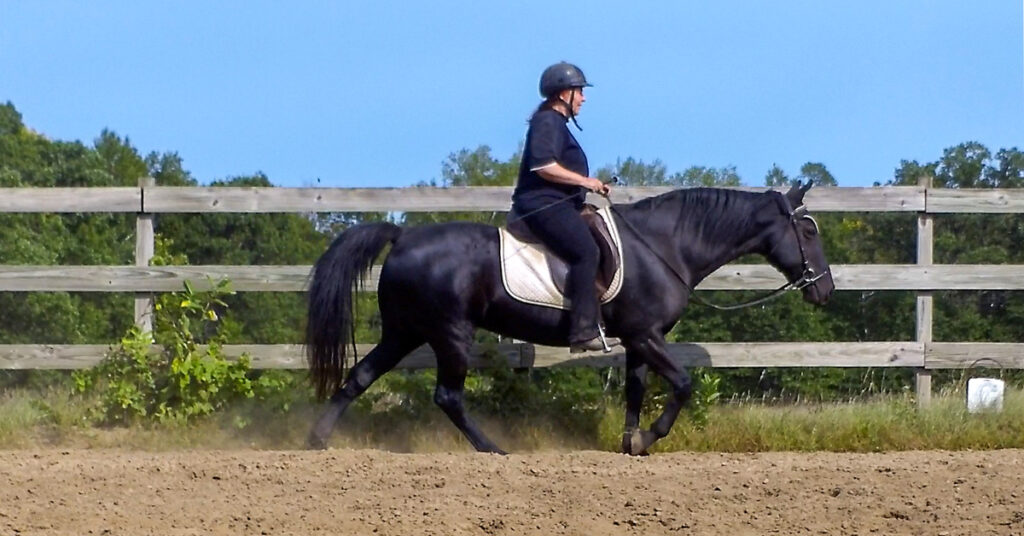What is the neck extension? How does it differ from long and low and how does each impact quality smooth gaits?
Many of us with naturally smooth gaited horses are familiar with the term long and low. For me, long and low was taught to help the naturally gaited horse relax and to break up pace into a smooth gait.
Before I purchased my first naturally gaited horse in 2007, I had been a dedicated student of dressage since 1988. I learned the benefits of stretching and developing the top line muscles of my trotting horse. I rode my horse forward in a long and low frame on a 20-meter circle and encouraged my horse to step its inside hind leg under the belly and beneath my center of gravity. Then I changed directions and repeated the exercise. Long and low on a 20-meter circle was taught as a way to warm up, relax, stretch, and cool down my horse.
However, as my late father would say, “Too much of anything isn’t good.” As I came to discover, too much long and low isn’t good either. It conditions the horse to travel on the forehand with disengaged chest muscles—kind of like slouching.
After a couple years of long and low with my Trakehner/Thoroughbred, First and Second Level dressage was a rude awakening. It was like starting our training over again, because my horse had been conditioned to travel on the forehand. First and Second Level dressage introduce balance with exercises like shoulder in, haunches in, and counter canter.
Three reasons why too much long and low puts the horse on the forehand:
- The head and neck of the horse weigh as much as 1/9th of its total body weight. When the head and neck are propelled ahead of the horse’s body mass, it places the horse on the forehand by nature. The lower the head and neck gets, the heavier the weight, especially for naturally gaited horses with a head and neck nod.
- In this long and low position, the horse’s chest muscles (pectoral and shoulder muscles) are collapsed and are not lifting the horse’s chest, head, neck and wither to place the horse in balance.
- When the horse’s head and neck get too low, the horse tends to disengage the hind legs beyond its tail. This further pushes itself onto the forehand. While the lowered head and neck position can help the horse find relaxation and stretch through the back, the disengaged hind quarters push the horse onto the forehand. This doesn’t lift a hollow back to a neutral position for a quality smooth gait.
A better way: moments (not miles) of neck extension AFTER balanced work
A few years ago, I learned about the neck extension from Ecole de Légèreté (School of Lightness) teachers. For me, learning the difference between the neck extension and long and low has been an real eye opener.
Why? Because up until this point, I didn’t have the riding awareness of how long and low had been training my naturally gaited horses to carry themselves on the forehand. The neck extension has brought all the benefits I had been seeking in long and low without the negative effects of collapsing the chest and shoulders.
How to apply the neck extension
- I begin with moments of balanced work in hand or in saddle at a halt or a slow walk.
- Then from a balanced frame, I proceed to the neck extension for a good stretch and reward. The neck extension can be done in hand, in saddle at a halt, or at a walk or gait.
Benefits of the neck extension
The neck extension trains my naturally gaited horses to:
- Stretch their head and neck forward and out to lengthen their spines
- Stretch their top line muscles
- Encourage them to step deeper under their belly with their hind leg steps
- Travel in a relaxed and forward rhythm without rushing, and
- Engage their abdominal muscles to lift their wither and back
Watch: Action-Reaction to Neck Extension
How to apply the neck extension
- First, I help my horse find balance and relaxation first through in-hand exercises that help her accept an even snaffle bit contact. These exercises help my horse unlock tension in her jaw as she tastes the bit. These in-hand exercises are then applied in the saddle before I ride.
- While riding I will follow the natural head and neck motion of my gaited horse to maintain an even snaffle bit contact to maintain relaxation of the jaw. Beginning lessons in Legerete: Following Hands»
- Instead of beginning my ride with long and low, I encourage my horse to walk in a slow, relaxed and balanced position while still tasting the bit, either in a shoulder-in or a small circle.
- After I achieve relaxation and balance, I release my horse into moments of the neck extension while she is already in balance. Then throughout our ride, I will ask for neck extension ride in all gaits, whether it be the walk, flat walk, running walk, foxtrot, trot (on cue) or canter.
- I begin the neck extension on a 20-meter circle and encourage her to step deeper under her belly and engage her abdominal muscles to lift her back to a neutral position.
Two differences between the neck extension and long and low
- A big difference between the neck extension and long and low is that the horse’s head and neck are no lower than poll level.
- It is also important to keep the horse’s nose ahead of the vertical with an open throat latch. This position helps minimize overweighting the forehand.
Comparisons of long and low and neck extension
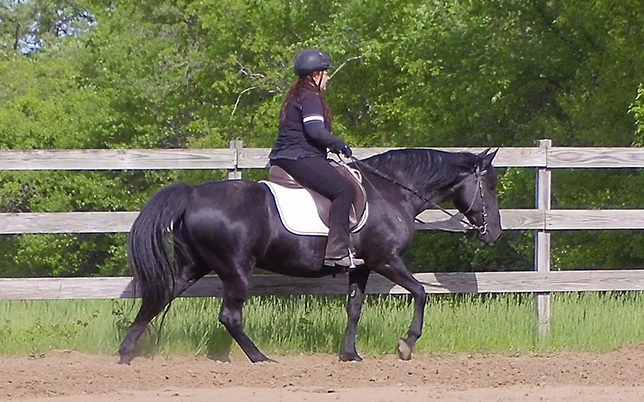
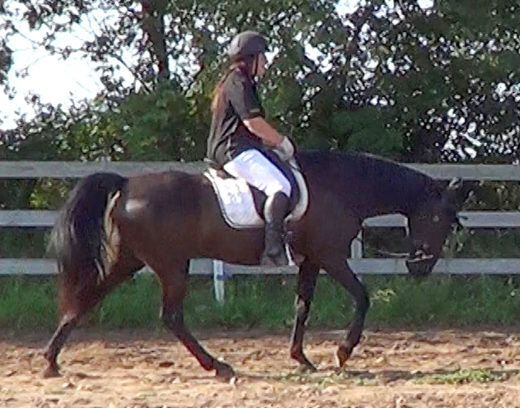
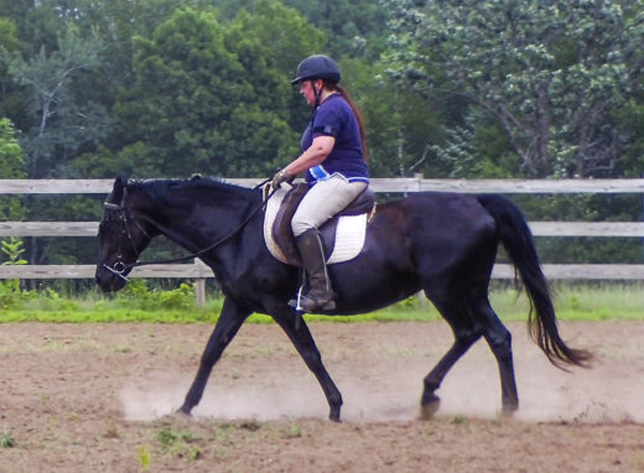
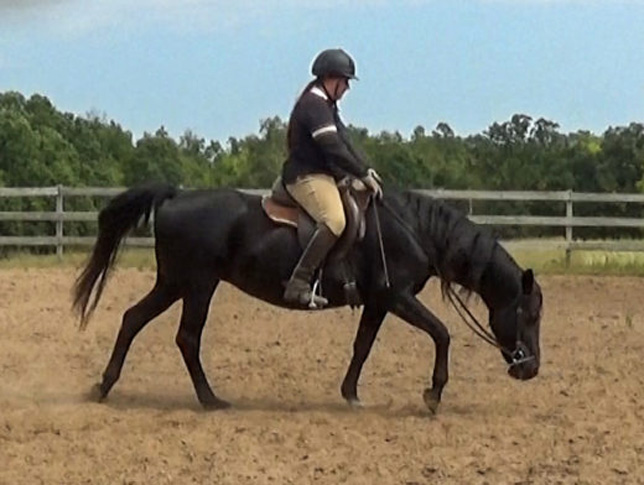
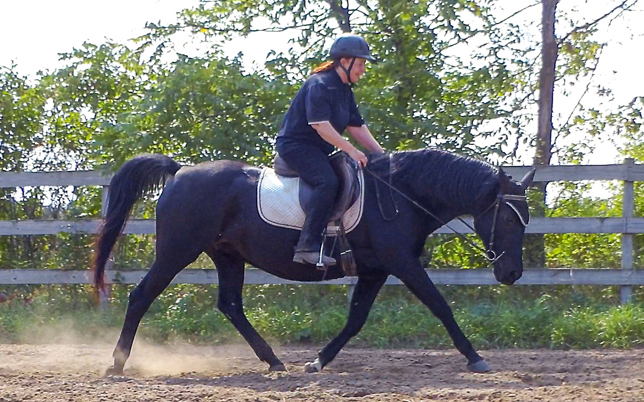
So, whether you’re training your naturally gaited horse to show gaited dressage or western gaited dressage or are looking to break up pace for a natural smooth gait, I hope learning the difference between long and low and neck extension will help bring awareness to your riding. Long and low stretching is great as long as the horse is in balance.
Avoid repetitive steps of a slouching posture: collapsing the chest, riding the horse on the forehand, hollow, behind the bit, out of balance, or disengaged (trailing its hind legs) instead of stepping under the rider.
Neck extension to improve quality smooth gait
Instead, try the neck extension in order to improve the quality of smooth natural four-beat gait. Encourage your horse to reache under its body with its hind leg steps, engage its abdominal muscles to lift its back to a neutral position, and stretches forward, down and out with the head and neck to lengthen the spine. All of which helps to build the top line muscles and break up pace.
If you are on this gaited dressage journey and have a question, I’d love to hear from you. Please contact me, “follow us” on NaturallyGaited Facebook, and subscribe to the NaturallyGaited YouTube channel.

